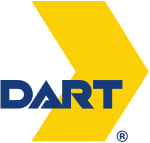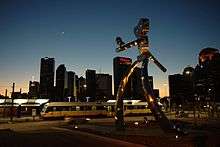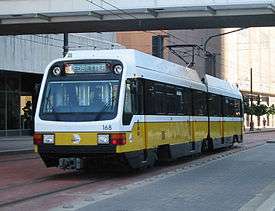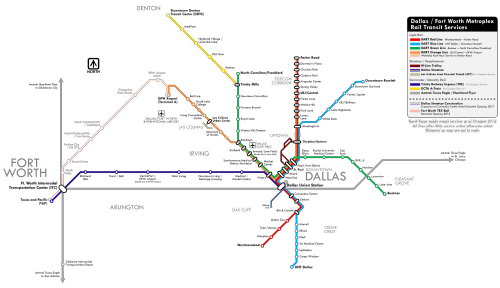DART Light Rail
 | |||
|
Blue Line train heading towards Ledbetter Station | |||
| Overview | |||
|---|---|---|---|
| Owner | DART | ||
| Locale | Dallas, Texas | ||
| Transit type | Light rail | ||
| Number of lines | 4 | ||
| Line number |
Red Line Blue Line Green Line Orange Line | ||
| Number of stations | 64 | ||
| Daily ridership | 97,800 FY 2015 [1] | ||
| Annual ridership | 29,884,200 (2014)[2] | ||
| Website | DART | ||
| Operation | |||
| Began operation | June 14, 1996[3] | ||
| Operator(s) | DART | ||
| Number of vehicles | 163 Kinki Sharyo[4] SLRVs | ||
| Technical | |||
| System length | 93 mi (150 km)[4] | ||
| Track gauge | 1,435 mm (4 ft 8 1⁄2 in) | ||
| Electrification | 750 V DC, overhead lines | ||
| |||
DART Light Rail is a light rail system in Dallas, Texas and its suburbs owned and operated by Dallas Area Rapid Transit. The system comprises 93 miles (150 km)[4] among its four lines — the Red Line, the Blue Line, the Green Line, and the Orange Line. It is the longest light rail system in the United States.[5] As of the fourth quarter of 2014, the system has an average weekday ridership of 101,800, making it the largest light rail system in the Southern United States by ridership, and the seventh largest in the United States by ridership.[2] As of Fiscal Year 2015, the system average weekday riderships had fallen to 97,800. [6] (The system utilizes 163 light rail trains manufactured by Kinki Sharyo,[4] with all trains being converted to "Super" LRVs which feature level boarding and higher passenger capacity.[7]
As of January 2016, following lines are currently active:
- Red Line (opened in 1996, completed in its current state in 2002)
- Blue Line (opened in 1996, completed in its current state in 2016)
- Green Line (opened in 2009, completed in its current state in 2010)
- Orange Line (opened in 2012, completed in its current state in 2014)
History
Before the 1983 election, DART had a plan for 160 miles (257.5 km) of rail. After the election, the plan was pared down to 147 miles (236.6 km) when Duncanville, Grand Prairie and Mesquite, which would have had rail lines, didn't opt to join the agency. DART chose light rail transit as its primary mode of rail transportation in 1984. The plan was pared down again to 93 miles (149.7 km) before the 1988 bond vote. After the vote, the agency again pared down the regional rail system to 84 miles (135.2 km); 66 miles (106.2 km) light rail and 18 miles of commuter rail. In 2010, DART announced that it would likely need to scrap much of its 2030 plan for expansion citing deficits and money woes.[8]
Starter system
After six years of scandals involving finances, delays in construction of the rail system, a failed bond election, and nine pull-out votes (two of which were successful), the year 1990 was a turning point for the agency when DART broke ground on its light rail system in October. The light rail system began service on time and on budget in June 1996,[9] inaugurating the first light rail system in Texas and the Southwest. Commuter rail service to Irving began in December, after some delays.
To the surprise of critics, the new light rail system was embraced by Dallasites, with ridership exceeding expectations. The suburbs' confidence in DART was also expressed at the ballot box: four cities held highly publicized pullout elections in 1996 (with the financial assistance of Dallas Cowboys owner Jerry Jones who wanted DART's half-cent sales tax revenue for Texas Stadium in Irving, the Cowboys' home at the time[10]), but all four voted to remain in DART (three of them by margins of more than two-to-one).
The 20 miles (32 km) starter system opened on June 14, 1996,[3] comprising the Red Line from the Westmoreland Road in West Oak Cliff through downtown Dallas to Pearl Street, and the Blue Line from Pearl Street to Morrell Station and Illinois Avenue.
The next stage of the starter line opened on January 10, 1997 when the Red Line was extended from Pearl Station to Park Lane Station. It includes the underground tunnel from Pearl Street to Mockingbird Lane, the latter being the site of Dallas's first modern transit village. The northern terminus of the Blue Line remained Pearl Station at that time.[11]
The starter line was completed when the Blue Line was extended from Illinois Station to its current southern terminus at Ledbetter Drive. This came on May 31, 1997, nearly one year after the first part of the starter system opened.
The final change to the starter system came on December 18, 2000 when DART opened Cityplace Station (now called Cityplace/Uptown Station), the first subway station in the Southwest, located in the tunnel between Pearl and Mockingbird Lane under the Tower at Cityplace skyscraper, providing access to the Tower as well as Cityplace West. It was the system's first in-fill stop.
Commuter rail on the old Rock Island right-of-way began during the series of openings of the light rail starter system. On December 30, 1996 the Trinity Railway Express opened the first segment as the South Irving Transit Center was connected to Union Station in downtown Dallas with a stop in the middle at Medical/Market Center Station. The agency had to lease rail cars due to a delay in the current stock until that March.

Suburban expansion
After the success of the light rail starter system, voters approved DART's request to use long-term bonds to expedite the construction of the regional light rail system. While DART had originally planned single-track extensions of the Blue Line to Garland and the Red Line to Richardson and Plano, the starter system was so popular that the agency made plans to double-track the entire route.
Work began on the extensions of both the Blue Line and the Red Line on January 15, 1999. Later that same year, on September 27, the Blue Line designation was extended to Mockingbird Lane, for its eventual expansion to Garland.[11] The first station since 1997 to open came on September 24, 2001, when the Blue Line was extended from Mockingbird Station to the new White Rock. Later, the Blue Line was further extended east outside the LBJ Loop when the LBJ/Skillman Station opened on May 6, 2002.
The first extension of the Red Line opened on July 1, 2002 when the line was extended 7 stations north from a newly rebuilt Park Lane Station to Galatyn Parkway. Richardson became the first Dallas suburb to be served by light rail.
The Blue Line was completed to Garland on November 18, 2002, making it the second suburb to get light rail service. The two new stations of Forest/Jupiter Station and Downtown Garland Station were opened to the public.[12]
The final stage of north-central and northeast "suburban" light rail expansion opened six months ahead of schedule when the Red Line extension to Downtown Plano and Parker Road opened on December 9, 2002, providing light rail service to Plano for the first time, and completing the current configuration of the Red Line.[13][14]
2030 Plan
In October 2006, the DART Board of Directors unanimously approved a long-term "2030 Plan", which included the following proposals for its next round of rail expansion:[15]
- A 2.9-mile (4.7 km) light rail extension of the Blue Line to Bonnie View Road and Interstate 20 to a new SouthPort intermodal port in southeast Dallas.
- A 4.3-mile (6.9 km) light rail extension of the Red Line south to Red Bird Lane.
- A 4.3-mile (6.9 km) light rail extension of the Orange Line along Scyene Road to approximately Masters Drive. The line would branch off the Green Line east of Lawnview Avenue.
- A 6-mile (10 km) light rail line in West Dallas along Fort Worth Avenue or Singleton to Loop 12/Jefferson Boulevard. No color designation was given for this planned line.
- A station for the Lake Highlands neighborhood of northeast Dallas on the Blue Line, between White Rock Station and LBJ/Skillman Station. This area previously opposed rail service, so the tracks were built through the area without a station. Lake Highlands opened on December 6, 2010, becoming the first component of the 2030 plan to be completed and the first infill station in DART's system.[16] This is a key component of the new Lake Highlands Town Center TOD development.[17]
- A nearly 26-mile (42 km) Cotton Belt Rail Line commuter service in the east-west Cotton Belt corridor from the Red Line in Plano to DFW International Airport. This line would provide rail service to the existing bus transfer station in Addison and would intersect the Green Line at Downtown Carrollton Station.
The final 2030 plan included several changes from the draft plan released in July 2006. Removed from the final plan was a 6.3-mile (10.1 km) branch of the Red Line from Forest Lane Station to the Addison Transit Center, which would have included several miles of subway under Interstate 635. DART officials cited the line's high cost, US$700 million, and lack of strong support from the city of Dallas. The Blue Line extension to the Dallas Southport Center (intermodal terminal) was added after strong pressure from Dallas officials. Also, the proposed light rail line serving West Dallas was not originally considered as a priority for rail service.
The Cotton Belt corridor plans continued to generate controversy right up to the day of the vote on the 2030 plan. DART leaned toward diesel powered commuter rail for the Cotton Belt corridor, similar to the Trinity Railway Express. However, the line would pass through affluent Far North Dallas neighborhoods, which formed the Cotton Belt Concerned Coalition to fight the line in 1990. The group lobbied for electric light rail vehicles on the line to avoid perceived air and noise pollution associated with diesel rail, and also proposed that the line be placed in a below-ground trench. These proposals were accepted by the City of Dallas in June 2006 in a unanimous resolution. DART, however, balked at the cost of trenching the line, which they estimated at $250 million. This set up a confrontation between DART and the city of Dallas, which appoints eight of the board's 15 members. The final plan compromised by promising $50 million "to help address neighborhood concerns".[18]
The current Cotton Belt freight corridor runs just south of the Downtown Plano Station on the Red Line, but DART maps of the 2030 plan indicated that the commuter rail line would run to the nearby Bush Turnpike station, the nearest station to the south of downtown Plano.[19] The Cotton Belt line would run through former DART member city Coppell between Carrollton and DFW Airport; although no station locations are included in the plan, the promise of a future station could entice Coppell, which withdrew from DART in 1989, into rejoining the agency.
In 2010, citing deficits and drops in revenue, DART scrapped much of their 2030 plan.[20]
Green and Orange Line expansion
On July 3, 2006, the Federal Transit Administration (FTA) approved a US$700 million Full Funding Grant Agreement (FFGA) — the largest grant ever awarded to DART — to kick-start a US$2.5 billion expansion of the light rail system. This phase included two new light rail lines that doubled DART's light rail mileage.[21] Construction began in September 2006. Upon completion of the project in 2013, the size of DART's light rail system doubled to 90 miles (145 km).[22]
In maps before 2006, DART labeled the Pleasant Grove to Carrollton route the "Orange Line", and the Irving route was the "Purple Line". Green was generally used on DART maps to denote the route of the Trinity Railway Express. By the time construction started, DART was using the new Green Line designation as part of its marketing efforts, saying "Like the color green, this line is a symbol of our city on the move."[23]
The Green Line began operation on September 14, 2009 with a route from downtown Dallas southeast to Fair Park; this short route was scheduled to open in time to service the 2009 State Fair of Texas. On December 6, 2010 the line extended further at both ends - to Pleasant Grove, as well as continuing northwest from Victory Station to Farmers Branch and Carrollton; both extensions, completing the Green Line.[24]
The northern end of Green Line connects with the A-train line run by the Denton County Transportation Authority (DCTA).[25] This line connects Denton to Carrollton, with stops in Lewisville and Highland Village. The commuter train may stop in other Denton County cities, should they choose to join the DCTA.
The second line, the Orange Line originates at LBJ/Central on the Red Line and runs concurrently with the Red Line to downtown, then with the Green Line to northwest of Love Field Airport at Bachman Lake, where it branches off toward Irving, then continuing to DFW International Airport. DART is cooperating with Love Field to link that airport to the Orange Line, but service is currently connected by a bus shuttle. The line runs through Las Colinas connects to the Las Colinas APT System. DART had preliminary plans for the Orange Line to run concurrently with the Red Line from downtown Dallas to LBJ/Central Station.[26] The line currently terminates at LBJ/Central Station with rush hour service to Parker Road Station. The first Orange Line stations opened on July 30, 2012, while service to Belt Line Station in Irving began on December 3, 2012.[27] An extension of the Orange Line from Belt Line Station to DFW Airport Station opened on August 18, 2014.[28]
Downtown Dallas (D2) Transit Study
In 2007, DART recognized that with Blue and Red Line trains sharing tracks through the Dallas Central Business District corridor, and the Orange and Green Lines also using this trunk segment through downtown, a single alignment would not have the capacity to support all four rail lines. Under a 1990 agreement with the City of Dallas, DART agreed to build a second rail alignment through downtown once certain operating or ridership figures were met, and DART projected that it would hit these targets by the early 2010s. As a result, DART commissioned its Downtown Dallas Transit Study, known as the D2 Study, to study the possibility of building a second rail alignment through downtown.[29]
In spring 2008, DART announced that it had considered 16 possible plans for a second rail alignment, and selected four for more detailed consideration. All four proposals provided for an alignment between Victory Station and Deep Ellum Station, indicating the D2 alignment would be used for Green and Orange Line service while the Red and Blue Lines would continue to use the existing alignment.[30] However, on April 27, 2010, DART announced that due to financial problems it would not be able to fund construction of the D2 alignment, putting the plan in limbo.[20]
After a three-year hiatus, DART announced on February 6, 2013 that it would begin holding public hearings on "Phase II" of the D2 study, to discuss alternatives and refinements to its D2 options since it ended "Phase I" of the D2 study in 2010.[31] At a public hearing on February 13, 2013, DART announced it was expanding to consider eight possible D2 alignments, some of which would connect to Union Station instead of Victory Station and thus provide Red and Blue Line service.[32] While the D2 Study is being funded by a $700,000 grant, the $500 million to $1 billion alignment is currently unfunded, and construction is not expected to begin before 2025.[32]
In August 2015, the Dallas City Council voted to only recommend an alignment along Jackson Street, over the objections of DART officials, who requested the addition of a Young Street route as a fallback. The alignment along Young Street was opposed by the First Presbyterian Church of Dallas, as the light rail would run through its property.[33]
Current lines
Red Line
The Red Line runs from southwest to northeast, from Westmoreland Station, in southwest Dallas, to Parker Road Station in Plano. Heading north from Westmoreland, the line provides service to Dallas Convention Center, Union Station, and the Dallas Central Business District, then follows Central Expressway (US 75) through north Dallas, Richardson and Plano.
Blue Line
The Blue Line runs from southwest to northeast, UNT Dallas, in southwest Dallas, to Downtown Rowlett Station in Rowlett. Heading north from UNT Dallas, the line provides service to Dallas Convention Center, Union Station, and the Dallas Central Business District, then turns northeast, providing service to White Rock Lake, Garland, and Rowlett.

Green Line
The Green Line runs from Buckner Station, near Loop 12 in southeast Dallas, to North Carrollton/Frankford Station in Carrollton in the northwest. Heading north from Buckner, the line serves Fair Park, Deep Ellum, and the Dallas Central Business District, then turns northwest along the Interstate 35E (Texas) corridor, serving the American Airlines Center, Parkland Hospital, Love Field, Farmers Branch, and Carrollton, where a transfer is available to the A-train line run by the Denton County Transportation Authority (DCTA).
Orange Line
The Orange Line runs between Parker Road Station in Plano and Dallas/Fort Worth International Airport. The Orange Line duplicates the Red Line along the Central Expressway (US 75) corridor from Parker Road to the Dallas Central Business District, then follows the Green Line along the Interstate 35E (Texas) corridor, serving the American Airlines Center, Parkland Hospital, and Love Field, before branching west along the Highway 114 corridor to Irving. The final leg of the Orange Line from Belt Line to DFW Airport opened on August 18, 2014.
Operation
The DART light rail system operates seven days a week from 4:30 a.m. to 12:30 a.m.[34] On each individual line, service operates Monday through Friday every 15 minutes during commute periods and every 20 minutes middays and early evening, while operating every 30 minutes after approximately 10 p.m. On Saturday and Sunday, service operates every 20 minutes between 9 a.m. and 8 p.m., and every 30 minutes early morning and at night. Portions of the system have headways cut in half where at least two lines share rail tracks, with all four lines which converge in downtown Dallas along the Pacific Avenue/Bryan Street corridor commanding headways of 3.5 minutes at the most to 5–7 minutes at the least.
See also
- List of DART Light Rail stations
- Dallas Streetcar
- McKinney Avenue Transit Authority
- Light rail in the United States
- List of United States light rail systems by ridership
- List of tram and light rail transit systems
References
- ↑ https://www.dart.org/about/dartreferencebookmar16.pdf
- 1 2 "Transit Ridership Report Fourth Quarter and End-of-Year 2014" (pdf). American Public Transportation Association (APTA). March 3, 2015. Retrieved January 1, 2016 – via http://www.apta.com/resources/statistics/Pages/ridershipreport.aspx.
- 1 2 "DART.org - DART History". Dallas Area Rapid Transit. 2013. Retrieved July 23, 2013.
- 1 2 3 4 "Facts about Dallas Area Rapid Transit (DART)". Dallas Area Rapid Transit. February 26, 2013. Retrieved July 23, 2013.
- ↑ David Crossley (December 6, 2010). "Dallas has longest light rail system in US". Houston Tomorrow. Retrieved June 13, 2012.
- ↑ https://www.dart.org/about/dartreferencebookmar16.pdf
- ↑ Facts:SLRV (DART Fact Sheets)
- ↑ Money woes will force DART to cut jobs, rail plans Dallas Morning News
- ↑ Kelley, Chris (June 16, 1996). "Last original staffer delivered train on time, within budget". The Dallas Morning News, p. 31A.
- ↑ Keep DART in Irving - Dallas Business Journal
- 1 2 Dallas Light Rail
- ↑ "Dallas: Light Rail Rolls into Garland, as Plano Gets Ready". Light Rail Progress. November 17, 2002. Retrieved April 12, 2013.
- ↑ "DART completes Red Line extension six months ahead of schedule". Progressive Railroading. November 27, 2002. Retrieved April 12, 2013.
- ↑ "Dallas: Modern Light Rail Rolls into Plano". Light Rail Progress. December 9, 2002. Retrieved April 12, 2013.
- ↑ Final DART 2030 System Plan
- ↑ DART.org - Blue Line Lake Highlands Station (accessed November 27, 2010)
- ↑ "Lake Highlands". Lakehighlandstowncenter.com. June 23, 2011. Archived from the original on July 24, 2012. Retrieved June 13, 2012.
- ↑ DART green-lights 40 miles of new rail for 2030
- ↑ DART 2030 Transit System Plan Map
- 1 2 Lindenberger, Michael (April 28, 2010). "Money woes will force DART to cut jobs, rail plans". Dallas Morning News. Retrieved April 12, 2013.
- ↑ "About DART". DART.org. Retrieved June 13, 2012.
- ↑ "About DART". DART.org. Retrieved June 13, 2012.
- ↑ Community Meeting/Public Hearing Notices - DART Green Line Expansion; 16 November 2006
- ↑ Solis, Dianne (June 10, 2009). "Officials reshaping downtown Carrollton around light-rail hopes". Dallas Morning News. Retrieved June 10, 2009.
- ↑ Peterson, Matt (June 20, 2011). "A-train railway begins rolling, carrying commuters from Denton to Carrollton". The Dallas Morning News. Retrieved June 20, 2011.
- ↑ NW Corridor FEIS, Figure 2-19 LRT Operating Plan
- ↑ "Facts: Orange Line". DART.org. Retrieved April 11, 2013.
- ↑ "DFW Airport Station triggers several DART train, bus changes". dallasnews.com. July 28, 2014. Retrieved August 13, 2014.
- ↑ "Downtown Dallas Transit Study Newsletter, Fall 2007". DART.org. Retrieved April 12, 2013.
- ↑ "Downtown Dallas Transit Study Newsletter, Spring, 2008". DART.org. Retrieved April 12, 2013.
- ↑ Wilonsky, Robert (February 6, 2013). "Dallas Area Rapid Transit announces public meeting (for next week!) to discuss long-delayed second downtown rail line". dallasnews.com Transportation Blog. Retrieved April 12, 2013.
- 1 2 Benning, Tom (February 14, 2013). "DART takes another look at second downtown Dallas line, even though project remains a long ways off". dallasnews.com Transportation Blog. Retrieved April 12, 2013.
- ↑ Formby, Brandon (August 24, 2015). "Dallas officials zero in on Jackson Street route for new DART tracks". The Dallas Morning News. Retrieved August 26, 2015.
- ↑ http://dart.org/schedules/schedules.asp DART Schedules
External links
| Wikimedia Commons has media related to DART Light Rail. |

